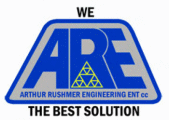
Contact Details:
Arthur Rushmer Engineering Ent cc
11 Beryllium Rd
Alrode
Alberton
Gauteng
1454
South Africa
Tel: +27 11 9084169
Fax: +27 11 8641588
Send Enquiry | Company Information

Screw vs rotary vane compressors: technology and maintenance
Product News Monday, September 27, 2010: Arthur Rushmer Engineering Ent cc
Different technology compressors show differing wear patterns, behave differently as they wear and have differing maintenance, lubrication and ownership costs.
Screw compressors
A screw compressor is most efficient when it is new and its clearances, compression cycle leakage and energy consumption (specific energy requirement) are at their minima. As the compressor runs, its efficiency declines. Dirt particles begin to clog the inlet filter and those that pass through the filter combine the lubricating oil to act like a grinding paste. Gradually clearances deviate from the original design, resulting in the blow-hole effect – air blowing back between the male and female rotors.
Leakage of air to the intake and to preceding pressure cells increases specific energy consumption. This is the primary reason why screw compressor manufacturers recommend air end exchanges between 20 000 and 50 000 operating hours.
Because of the large amount of metal that must be removed during machining, the rotors of a screw compressor are made of malleable mild grade steel. The surface of the metal is not porous and it does not retain oil. As a result of metal to metal contact during each start up, galling occurs. A pair of rotors that have been in service for less than 2000 hours will have gaps in the seal landings on the outer diameter of the rotor lobes, and numerous scars on the flanks of the lobes. On commissioning the intake of a screw compressor has to be bled to avoid harmful metal to metal contact.
It is impossible to produce screw compressor lobe forms that mesh perfectly. During most of the cycle leakage paths exist, which allow air to escape from the high pressure zone to the intake. The leakage through these paths is constant. The effect of this is that the percentage of leakage lessens at higher speed and increases at lower speed. This low speed characteristic causes the screw compressor to absorb high kW at low rotational speed unless the speed is regulated by inverter technology. Even then there is a threshold of 40% otherwise efficiency is compromised to a greater degree than with rotary vane technology.
The number of bearings required on each rotor of a screw compressor is double that required on a rotary vane compressor. Due to the thrust created during compression, the rotors of a screw compressor have to be fitted with expensive high quality thrust bearings to ensure fixed clearances and to absorb radial and axial loading. Generally, angular contact ball bearings have limited capacity in both directions and consequently a life expectancy of approximately 20 000 operating hours. This is further complicated by the high speed that these machines run at to obtain output, especially for oil-free models. The effect of bearing failure on a screw compressor is often complete destruction of the screw air end. The replacement cost of the air end can reach 70% of the compressor cost.
Rotary vane compressors
Rotary vane compressors do not degrade with wear but actually improve. As the blades seat in on the stator and rotor slots, leakage and power consumption are reduced and the compressor efficiency stabilises at a level up to 5% higher than when new. Clearances are maintained at a minimum throughout the life of the compressor by controlling wear factors primarily through the use of superior lubricants. A decade ago lubricant technology required rotary vane manufacturers to replace lubricant every 400 hours to ensure long bearing life and low wear. Today these replacement intervals have been extended through the use of heavyweight oils which are compatible with cast iron, porous materials and white metal.
The vane compressor has a single rotor with matched alloy blades, two white metal bearings housed in end covers, and a stator manufactured from high quality porous material. Cast iron is a superb absorber and bearing material because of the free carbons, hard iron carbides and their oil retaining qualities. There is no metal-to-metal contact between the moving parts; not even directly between the blades and the stator. Modern rotary vane compressor blades are made of superior quality materials that are machined and processed robotically to produce a high quality standard and superior wear resistance. Rotor and stator material selection in combination with modern lubricants eliminates galling and reduces wear to almost zero over the life of the compressor. Modern rotary vane compressor blades have a 100 000 hour-plus life expectancy.
Fixed speed rotary vane compressors run at a speed of 1450 rpm and most are directly coupled with no thrust on compressor or motor bearings with horizontal orientation, only producing radial loading for which white metal has proven to be the best solution. Using correctly sized white metal bearings in conjunction with suitable lubricants and maintenance, the majority of rotary vane compressors will use only one set of bearings throughout their life.
The maintenance aspect of items like synthetic lubricant, lubricant filters and separator changes, are not always similar. Certain types of rotary vane compressors have superior lubricant separation systems and separator element changes are only necessary after 10 000 operating hours while other designs of separation require separator element changes at 6000 hours.7
